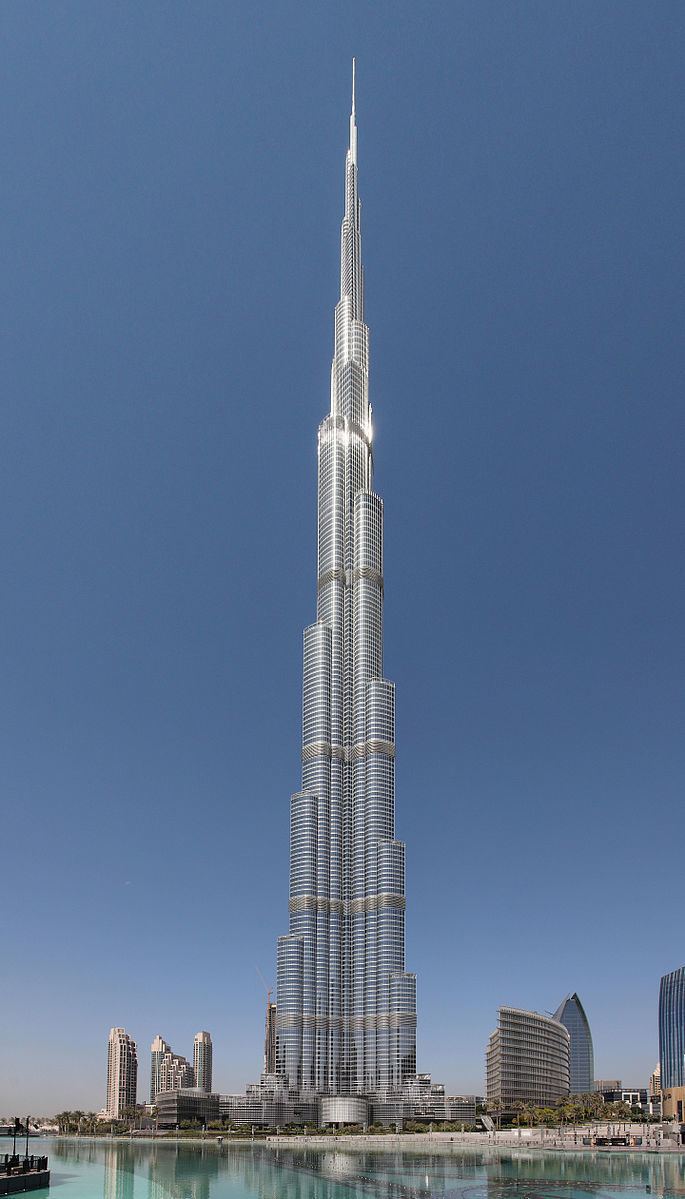 | ||
This list of tallest buildings in the world ranks skyscrapers by height. Only buildings with continuously occupiable floors are included, thus non-building structures, including towers, are not included. (See List of tallest buildings and structures.)
Contents
Ranking criteria and alternatives
The international non-profit organization Council on Tall Buildings and Urban Habitat (CTBUH) was formed in 1969 and announces the title of "The World's Tallest Building" and sets the standards by which buildings are measured. It maintains a list of the 100 tallest completed buildings in the world. The organization currently ranks Burj Khalifa in Dubai as the tallest at 828 m (2,717 ft). The CTBUH only recognizes buildings that are complete, however, and some buildings listed within these list articles are not considered complete by the CTBUH.
In 1996, as a response to the dispute as to whether the Petronas Towers or the Sears Tower was taller, the council listed and ranked buildings in four categories:
Spires are considered integral parts of the architectural design of buildings, to which changes would substantially change the appearance and design of the building, whereas antennas may be added or removed without such consequences. The Petronas Towers, with their spires, are thus ranked higher than the Willis Tower (formerly the Sears Tower) with its antennas, despite the Petronas Towers' lower roofs and lower highest point.
Until 1996, the world's tallest building was defined by the height to the top of the tallest architectural element, including spires but not antennae. This led to a rivalry between the Bank of Manhattan Building and the Chrysler Building. The Bank of Manhattan Building employed only a short spire and was 927 ft (282.5 m) tall and had a much higher top occupied floor (the second category in the 1996 criteria for tallest building). In contrast, the Chrysler Building employed a very large 125 ft (38.1 m) spire secretly assembled inside the building to claim the title of world's tallest building with a total height of 1,046 ft (318.9 m), although it had a lower top occupied floor and a shorter height when both buildings' spires were excluded.
Upset by Chrysler's victory, Shreve & Lamb, the consulting architects of the Bank of Manhattan Building, wrote a newspaper article claiming that their building was actually the tallest, since it contained the world's highest usable floor. They pointed out that the observation deck in the Bank of Manhattan Building was nearly 100 ft (30.5 m) above the top floor in the Chrysler Building, whose surpassing spire was strictly ornamental and inaccessible.
At present, the Burj Khalifa tops the list by some margin, regardless of which criterion is applied.
Tallest buildings in the world (300 m+)
As of 2016, this list includes all 135 buildings (completed and architecturally topped out) which reach a height of 300 metres (984 ft) or more as assessed by their highest architectural feature. Seven of the last eight buildings to have held the record as 'tallest building' are still found in the list, with the exception being the North Tower of the original World Trade Center after its destruction in the September 11 attacks of 2001.
Countries with the most entries in the list
The countries with three or more buildings taller than 300 meters are:
The count for China includes six in Hong Kong and, with the exception of a dozen buildings, all are relatively new, having been completed in and after 2010. Worldwide, as there are plans in the next five years for more than 80 buildings in the same height range (including about 40 in China), then the list should have a total of about 200 buildings by the year 2020.
Height to pinnacle (highest point)
This measurement disregards distinctions between architectural and non-architectural extensions, and simply measures to the highest point. This measurement is useful for air traffic obstacle determinations, and is also a wholly objective measure. However, this measurement includes extensions that are easily added, removed, and modified from a building and are independent of the overall structure.
This measurement only recently came into use, when the Petronas Towers passed the Sears Tower (now called Willis Tower) in height. The former was considered taller because its spires were considered architectural, while the latter's antennae were not. This led to the split of definitions, with the Sears Tower claiming the lead in this and the height-to-roof (now highest occupied floor) categories, and with the Petronas claiming the lead in the architectural height category.
Buildings under construction
This is a list of 82 buildings taller than 300 metres or 65 floors that are currently under construction. More than half of the buildings are located in China.
List by continent
The following list shows the tallest completed buildings located in each continent listed by greatest to least height:
